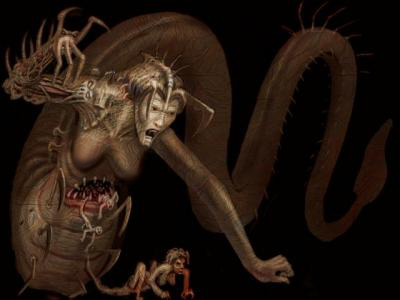|
Roman Strix :
A strix (Latin: strix, from Ancient Greek: στρίγξ "screecher", hence "owl"), plural strigēs or strixes, occasionally corrupted to stirge, was an Ancient Roman legendary creature, usually described as a nocturnal bird of ill omen that fed on human flesh and blood like a vampire. However, the strix was not a revenant—a risen corpse—but the product of shape-shifting.
The earliest recorded tale of the strix is from the lost Ornithologia of the Greek author Boios, which is partially preserved in Antoninus Liberalis's Metamorphoses. This tells the story of Polyphonte and her two sons Agrios and Oreios (their father being a wild bear), who were punished for their cannibalism, like Lycaon, by being transformed into wild animals. Polyphonte became a στρίγξ "that cries by night, without food or drink, with head below and tips of feet above, a harbinger of war and civil strife to men".
The first Latin allusion is in Plautus's Pseudolus, dated to 191 BC, in which a cook, describing the cuisine of his inferiors, compares its action to that of the strigēs—i.e., disemboweling a hapless victim. Horace, in his Epodes, makes the strix's magical properties clear: its feathers are an ingredient in a love potion. Seneca the Younger, in his Hercules Furens, shows the strigēs dwelling on the outskirts of Tartarus.
Ovid tells the story of strigēs attacking the legendary king Procas in his cradle, and how they were warded off with the leaves of the Strawberry Tree (Latin: arbutus) and placated with the meat of pigs as an explanation for the custom of eating beans and bacon on the Kalends of June.
Though descriptions abound, the concept of the strix was nonetheless vague. Pliny, in his Natural History, confesses little knowledge of them; he knows that their name was once used as a curse, but beyond that he can only aver that the tales of them nursing their young must be false, since no bird except the bat suckled its children.

The legend of the strix survived into the Middle Ages, as recorded in Isidore's Etymologiae,and gave both name and attributes to strigă, the name of a Romanian imaginary evil feminine being (also the name of the Common Barn Owl and of the Death's-head Hawkmoth) and strigoaică witch, strigoi "vampire" and to the Italian: strega "witch". Strigă was further borrowed into Albanian: shtriga and Polish: strzyga (via Gorals)
|

